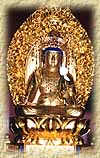Shou
Kannon Bodhisattva
This
figure of Ensen-ji wears a crown topped with tiny images
of Amida Nyorai (Amitabha Tathagata), drapes silk cloth
round the body (called "jyohaku"), wears a kind
of loose, pleated trousers (called "mo"), and
also drapes a heavenly garment known as "tenne"
round his hands and body. Kannon is adorned with a
brooch, bracelet, and necklace, and sits cross-legged on
a lotus flower. The figure is 36.2 cm (about 14.3 inches)
high and is constructed by assembling separately carved
blocks of wood ("yosegi-tsukuri" as previous
explained). It was probably made some time in the Edo
Period.
|
|
 |